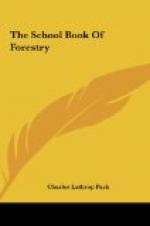Sportsmen are so numerous and hunting is so popular, that game refuges have to be provided in the forests and parks. Were it not for these havens of refuge where hunting is not permitted, some of our best known wild game and birds would soon be extinct. There are more than 11,640,648 acres of forest land in the government game refuges. California has 22 game refuges in her 17 National Forests. New Mexico has 19, while Montana, Idaho, Colorado, Washington and Oregon also have set aside areas of government forest land for that purpose. In establishing a game refuge, it is necessary to pick out a large area of land that contains enough good feed for both the summer and winter use of the animals that will inhabit it.
[Illustration: A forest ranger and his forest Cabin]
Livestock is sometimes grazed on game refuges, but only in small numbers, so that plenty of grass will be left for the support of the wild game. The refuges are under the direction of the Federal and the State game departments. To perpetuate game animals and game birds, it is not enough to pass game laws and forbid the shooting of certain animals and birds except at special times of the year; it is also necessary to provide good breeding grounds for the birds and animals where they will not be molested or killed. The game refuges provide such conditions.
The division of the range country into small farms and the raising of all kinds of crops have, it is claimed, done more to decrease our herds of antelope, elk, deer and other big game than have the rifles of the hunters. The plow and harrow have driven the wild life back into the rougher country. The snow becomes very deep in the mountains in the winter and the wild animals could not get food were it not for the game refuges in the low country. In the Yellowstone National Park country great bands of elk come down from the mountains during severe winters and have to be fed on hay to keep them from starving, as there is not sufficient winter range in this region to supply food for the thousands of elk.
Where the elk are protected from hunters they increase rapidly. This means that some of the surplus animals have to be killed, otherwise, the elk would soon be so numerous that they would seriously interfere with the grazing of domestic livestock. In different sections of the elk country, a count is made every few years on the breeding animals in each band. Whenever a surplus accumulates, the state permits hunters to shoot some of the elk. If the breeding herds get too small, no hunting is allowed. In this way, a proper balance is maintained.
In many states the wild game birds and fur-bearing animals of the forests are protected by closed seasons during which hunting is not permitted. It is realized that birds and animals are not only of interest to visitors to the forests, but that they, as well as the trees, are a valuable forest product.




